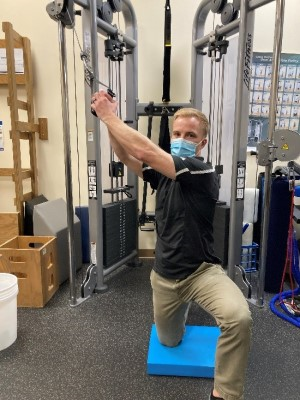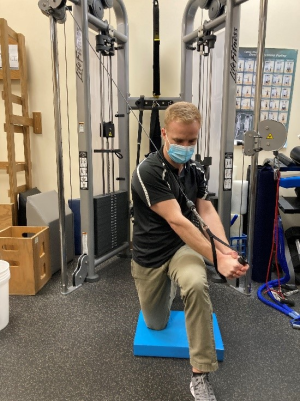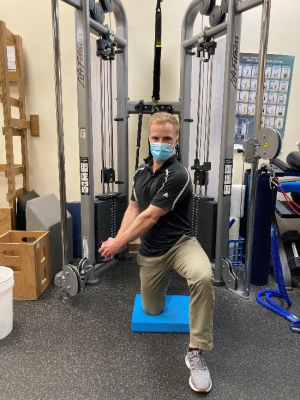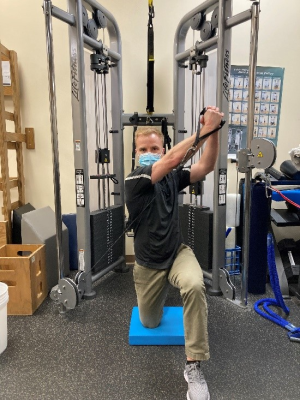
How to Get the Most out of Your Workout
Leave a CommentThere are often multiple desires when it comes to exercising. We want to look better, get more toned, feel better physically or psychologically, or lose weight. It is possible to achieve many of these things simultaneously but having a goal and an exercise routine geared toward your wants and needs is the road map that can make you more successful. This blog will discuss strategies for goal setting and the SAID principle to help you choose activities to get the results you desire.
Many people are familiar with the acronym SMART; specific, measurable, attainable, realistic, and timely for goal setting. This is a good foundation, but knowing what is attainable for you is often hard to gauge. A strategy you could use to address this problem is a goal attainment scale (GAS). When turning your regular goal into a GAS goal, you create a range of outcomes that you could achieve from -2 to +2, with 0 being your target goal1.
Here is an example:
Goal: Run the Rock ‘n’ Roll 5k race on June 22nd, 2022, in Chicago, IL, in 29 minutes.
- -2: 33 minutes
- -1: 31
- 0: 29 minutes
- +1: 27 minutes
- +2: 25 minutes
GAS goals can help a person reorient to their goal if they are either over or underachieving what they had initially expected. Give it a try the next time you create a goal for yourself.
One of the most powerful theories in exercise physiology is, “Specific adaptations to imposed demands,” also known as the SAID principle. In other words, physiologic changes to the body will correspond to the way the body is challenged2. This theory may be simple, but it is profoundly powerful. I was first taught this principle through the story of Milo of Croton. It is said that Milo lifted and carried a newborn calf every day for four years. As the calf grew larger day by day into a mature ox, Milo grew extremely strong and became a great wrestler3. The sport of wrestling requires you to control your opponent and sometimes lift them; imagine trying to control an ox and lift it. There is a clear, direct relationship between the tasks, and hence a clear reason why the adaptations from lifting the ox resulted in a high capacity for wrestling. A training example that I believe many individuals can apply the SAID principle is core training. Crunches and sit-ups may be good for stimulating your rectus abdominis, otherwise known as abdominal muscles, and your hip flexors; however, the core stabilizes and has three-dimensional movement. It only makes sense that we should train all three planes individually, and eventually two to three planes at once. To better prepare your core for life’s demands, consider core activities like a chop and lift with a light resistance band and progressing to weighted medicine balls or sandbags. See the images below for examples of the two exercises.
Chop Exercises


Lift Exercises


At Athletico, we hope that you continue to lead an active lifestyle and that you achieve all of your movement goals. If you find that you are reaching plateaus in your goals or that pain limits your progress, you may benefit from a free assessment. Our team will assess your functional strength, mobility, and balance to determine a customized treatment program to fit your needs. Free Assessments are available in-clinic and virtually through our Telehealth platform.
The Athletico blog is an educational resource written by Athletico employees. Athletico bloggers are licensed professionals who abide by the code of ethics outlined by their respective professional associations. The content published in blog posts represents the opinion of the individual author based on their expertise and experience. The content provided in this blog is for informational purposes only, does not constitute medical advice and should not be relied on for making personal health decisions.
References:
1. Lynne Turner-Stokes DM FRCP, “Goal Attainment Scaling in Rehabilitation a Practical Guide”. , www.sralab.org. Assessed 21st of March 2022.
2. William A Sands et al. “The National Strength and Conditioning Association’s (NSCA) BASICS OF STRENGTH AND CONDITIONING MANUAL”. www.nsca.com. Assessed 21st of March 2022.
3. Spivey, Nigel Jonathan (2004). The Ancient Olympics. Oxford and New York: Oxford University Press. pp. 65–66, 100–101. ISBN 978-0-19-280433-4.
